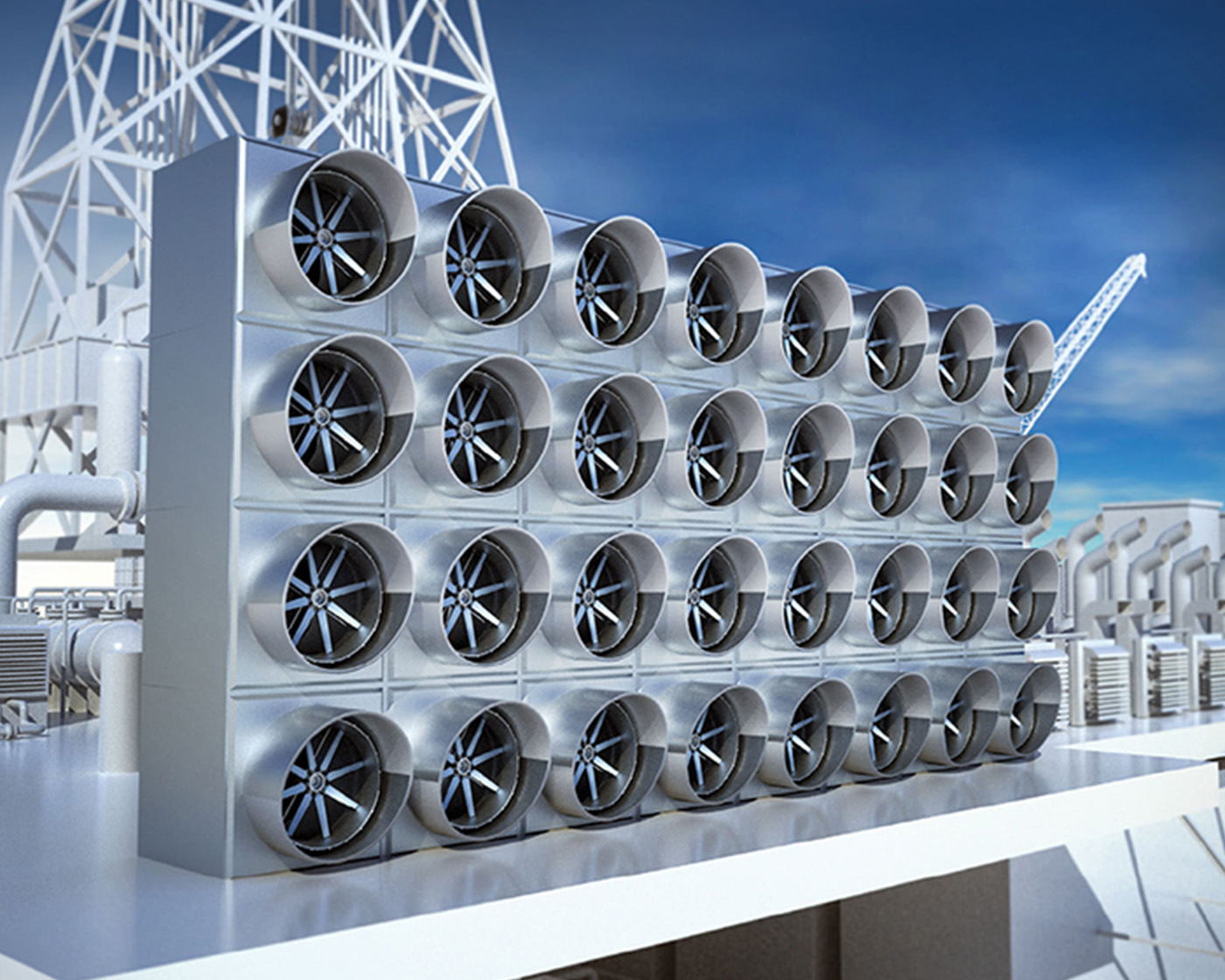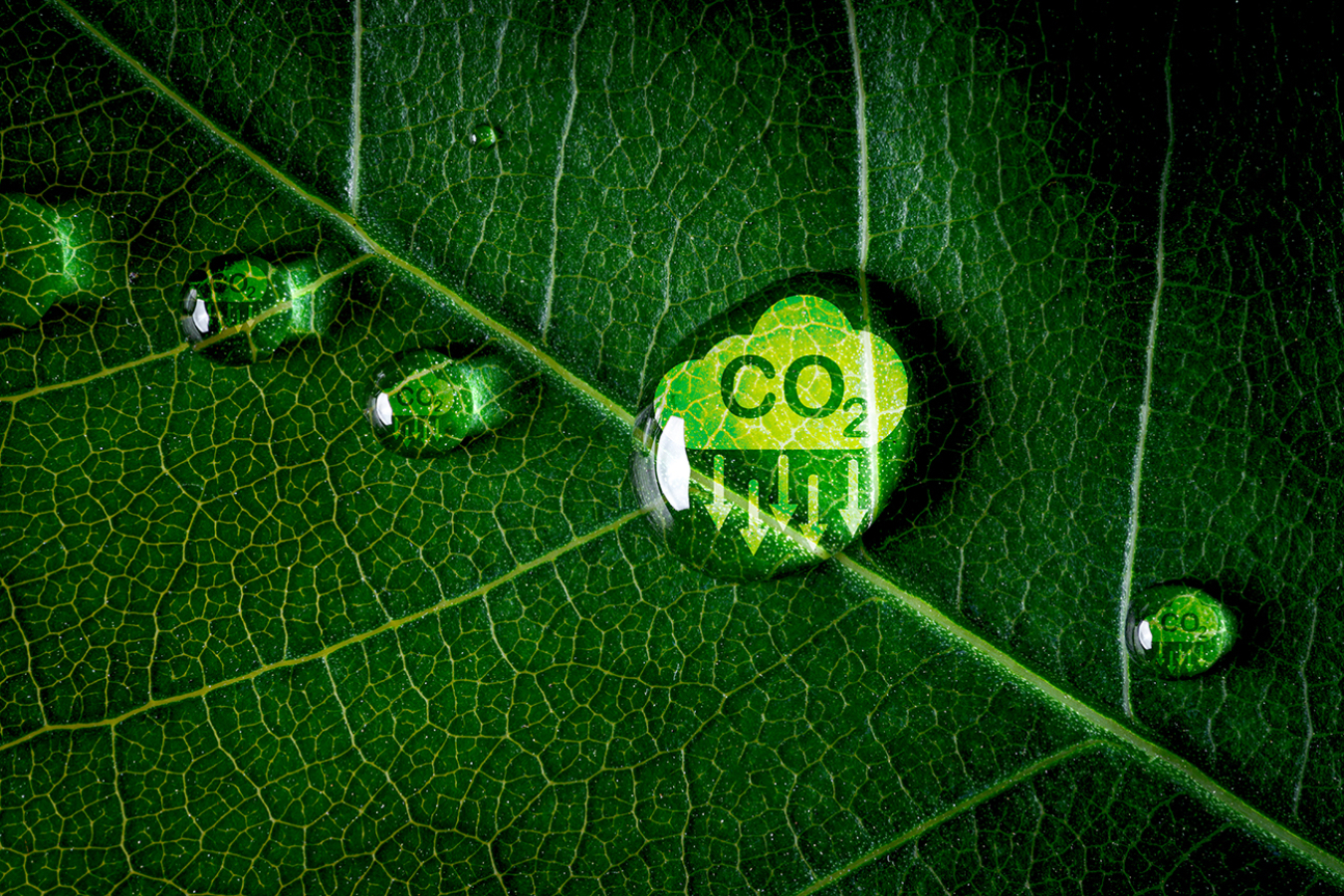Carbon dioxide removal draws down greenhouse gas emissions, reducing warming effects.
In November 2021, DOE launched the Carbon Negative Shot to advance the development of this emerging, but necessary carbon dioxide removal industry. By 2032, this all-hands-on-deck approach to carbon dioxide removal innovation aims to achieve carbon dioxide removal that is affordable (<$100 per tonne averaged across pathways), durable (100+ years), and gigatonne(s) in scale.
Carbon dioxide removal refers to a diverse array of approaches that remove carbon dioxide—direct air capture with storage, soil carbon storage, biomass carbon removal and storage, enhanced mineralization, marine carbon dioxide removal, and afforestation/reforestation—from the atmosphere and ocean. The carbon dioxide is then stored in geological, terrestrial, or ocean reservoirs, or in long-lived products.
Large-scale carbon dioxide removal is essential to achieving global climate goals of limiting global warming to 1.5⁰C above pre-industrial levels to avoid the worst impacts of climate change. Several climate models, including those produced by the United Nations Intergovernmental Panel on Climate Change, show that reducing carbon dioxide emissions alone is not enough to combat climate change. Why? Because reducing emissions alone doesn’t address the trillions of tonnes of carbon dioxide already in our atmosphere. While the exact amount of carbon removal required depends on the speed of emissions reductions, scientists widely agree that carbon dioxide removal is necessary.
To reach net-zero carbon, we must continue to rapidly reduce emissions and deploy clean energy technologies. In parallel, we will also need to remove carbon dioxide to address residual emissions from hard-to-abate industries, such as agriculture and shipping.

The climate crisis calls for a different kind of moonshot. Energy Earthshots will accelerate breakthroughs of more abundant, affordable, and reliable clean energy solutions within the decade. They will drive the major innovation breakthroughs that we know we must achieve to solve the climate crisis, reach our 2050 net-zero carbon goals, and create the jobs of the new clean energy economy. The Energy Earthshots target the remaining solution points of the most challenging technical problems across our energy economy.
Highlights
-

- Fossil
The Carbon Negative Shot™ is an all-hands-on-deck call for innovation in carbon dioxide removal pathways that will capture carbon dioxide from the atmosphere and store it at gigaton scales for less than $100/net metric ton of carbon dioxide-equivalent.January 16, 2025 -
 Approaches that remove carbon dioxide (CO2) from the atmosphere.November 24, 2024
Approaches that remove carbon dioxide (CO2) from the atmosphere.November 24, 2024 -
DOE's Carbon Dioxide Removal: Purpose, Approaches, and Recommendations Report is open for public comment.January 16, 2025

Impact and Engagement
Achieving the Carbon Negative Shot goal will help spur innovation and position U.S. enterprises as leaders in research, manufacturing, and deployment in a carbon dioxide removal industry that must have a rapid, global ramp-up by mid-century.
It will also position America to lead the way to acheiving net-zero carbon on a global scale, eventually remove legacy greenhouse gas emissions from the atmosphere, create good-paying job opportunities that build on the skillsets of the fossil fuel workforce, and prioritize community needs.
As a driver for this necessary and emerging industry, Carbon Negative Shot prioritizes information sharing and engagement with communities that could participate in or be affected by carbon dioxide removal, including environmental and climate organizations, tribal nations, labor groups, industry, and academia. Carbon Negative Shot also supports a whole-of-government approach and seeks alignment in federal, state, and local areas.
Featured Video
Carbon Negative Shot Summit
On July 22, 2022, the U.S. Department of Energy hosted the Carbon Negative Shot Summit, which convened industry innovators, environmental and climate justice organizations, labor unions, academia, government leaders, and many more in order to increase collaboration to advance deployment of commercially viable, just, and sustainable carbon dioxide removal in the United States.
Supporting Offices
Resource Library
On November 21, 2021, President Biden signed the Infrastructure Investment and Jobs Act, also known as the Bipartisan Infrastructure Law. The infrastructure deal includes more than $62 billion for the U.S. Department of Energy (DOE) to deliver a more equitable clean energy future for the American people by investing in American manufacturing and workers; expanding access to energy efficiency and clean energy for families, communities, and businesses; delivering reliable, clean, and affordable power to more Americans; and building the technologies of tomorrow through clean energy demonstrations. It also specifically includes historic investments in carbon management, both to mitigate and remove carbon dioxide emissions.
As a part of the Bipartisan Infrastructure Law, DOE will deploy approximately $12 billion in new carbon management funding over five years, largely for direct air capture and carbon capture, transport, and storage.
Read the Bipartisan Infrastructure Law Opportunities to Accelerate Deployment in Fossil Energy and Carbon Management Activities fact sheet to see the funding breakdowns.
On August 16, 2022, President Biden signed the Inflation Reduction Act (IRA). This landmark legislation makes a historic commitment to climate action that will drive innovation and deployment of clean energy, industrial and manufacturing technologies, and infrastructure to put our nation on track to meet the President’s ambitious goal of achieving net-zero emissions economy-wide by 2050, while investing in communities and American workers.
The IRA features a comprehensive package of clean energy and industrial tax credits, including the most ambitious incentives in the world to date for the deployment of carbon management technologies, such as carbon capture, direct air capture, and the conversion of captured carbon emissions into useful products.
Substantial improvements to the federal 45Q tax credit include increased credit values to $85 per ton of carbon oxide captured and stored from industrial facilities and power plants and $180 per ton for direct air capture facilities, an extension of the credit to a full ten years, the ability to claim the credit directly as a cash payment, and expanded eligibility for smaller direct air capture, industrial, and power generation facilities.
- Office of Fossil Energy and Carbon Management’s Funding Opportunities
- Office of Energy Efficiency and Renewable Energy’s Funding Opportunities
- Office of Science’s Funding Opportunities
- Advanced Research Projects Agency-Energy’s Funding Opportunities
- Office of Clean Energy Demonstrations’ Funding Opportunities
- Carbon Negative Shot Strategy
- National Risk Assessment Partnership
- Carbon Management Interactive Diagram
- Direct Air Capture 101 (2022)
- Carbon Storage Atlas (2015)
Fact Sheets
- Carbon Dioxide Removal (2023)
- Carbon Dioxide Removal Program (2023)
- Carbon Negative Shot (2022)
- Foundational Science for Carbon Dioxide Removal Technologies (2022)
- DOE Explains the Carbon Cycle
Infographics
Reports
- DOE's Carbon Dioxide Removal: Purpose, Approaches, and Recommendations Draft Report for Public Comment (2025)
- Best Practices for Life Cycle Assessment of BiCRS (2025)
- Carbon Negative Shot: Technological Innovation Opportunities for Carbon Dioxide Removal (2024)
- Best Practices for Life Cycle Assessment of Direct Air Capture with Storage (2022)
- Carbon Transport and Storage R&D Priorities for Repurposing Infrastructure (2022)
- Fossil Energy and Carbon Management Strategic Vision (2022)
- Rules and Tools Crosswalk: A Compendium of Computational Tools to Support Geologic Carbon Storage Environmentally Protective UIC Class VI Permitting (2022)
- Best Practices: Monitoring, Verification, and Accounting (MVA) for Geologic Storage Projects (2017)
- Basic Research Needs for Carbon Capture: Beyond 2020 (2010)
- Carbon Cycling and Biosequestration, Integrating Biology and Climate through Systems Science (2008)
Fact Sheets and Infographics
- Chan Zuckerberg Initiative, What Is Carbon Dioxide Removal (2022)
- GCCSI, Carbon Dioxide Removal Approaches (2021)
- United States Executive Office of the President, The Long-Term Strategy of the United States: Pathways to Net-Zero Greenhouse Gas Emissions by 2050 (2021)
Reports
- Lawrence Livermore National Laboratory, Roads to Removal: Options for Carbon Dioxide Removal in the United States (2023)
- IEA, CO2 Capture and Utilisation (2022)
- Intergovernmental Panel on Climate Change (IPCC), AR6 Climate Change 2022: Mitigation of Climate Change (2022)
- Carbon Dioxide Removal Mission, Carbon Dioxide Removal Technology Roadmap: Innovation Gaps and Landscape Analysis (2022)
- National Academies of Sciences, Engineering, and Medicine, A Research Strategy for Ocean-based Carbon Dioxide Removal and Sequestration (2022)
- Ocean Visions, Macroalgae Cultivation & Sinking for Carbon Sequestration (2022)
- U.S. Department of Agriculture, Climate-Smart Agriculture and Forestry Strategy: 90-Day Progress Report (2021)
- Aspen Institute, Guidance for Ocean based Carbon Dioxide Projects Report (2021)
- Bipartisan Policy Center, The Business Case for Direct Air Capture (2021)
- OSTI, Biomass Carbon Removal and Storage (BiRCS) Roadmap (2021)
- Progress in Energy, A review of direct air capture (DAC): scaling up commercial technologies and innovating for the future (2021)
- Wilcox, Freeman, Kolosz, CDR Primer (2020)
- Carnegie Mellon University, Real Time Decision Making for the Subsurface (2019)
- National Academies of Sciences, Engineering, and Medicine, Negative Emissions Technologies and Reliable Sequestration (2019)
- Oakridge National Laboratory, MODIS and VIIRS Land Products Global Subsetting and Visualization Tool (2018)
- Sanderman, Jonathan, Global Mangrove Soil Carbon: Dataset and Spatial Maps (2017)
Carbon Management Challenge
The Carbon Management Challenge recognizes the importance of deploying, at scale, carbon capture, utilization, and storage and carbon dioxide removal, complemented by the expansion of renewable and nuclear energy, ending net deforestation, and reducing methane emissions. Members of the Challenge, co-sponsored by Brazil, Canada, Indonesia, the United Kingdom, and the United States, advance a global goal of expanding carbon management projects to reach gigaton scale annually by 2030. At COP28, the Challenge announced new participants, including Iceland, Indonesia, Kenya, Mozambique, Netherlands, Romania, and Senegal.
Carbon Dioxide Removal Launchpad
As a co-lead of the Carbon Dioxide Removal Launchpad, DOE and a coalition of countries, including Canada, the European Commission, Iceland, Japan, Norway, and the United Kingdom, are working to reduce the costs and accelerate the development of carbon dioxide removal technologies. Members of the Carbon Dioxide Removal Launchpad agreed to build at least one 1,000+ ton/year carbon dioxide removal project by 2025, contribute to a collective $100 million investment for demonstration projects by 2025, and support efforts to advance measurement, reporting, and verification.

